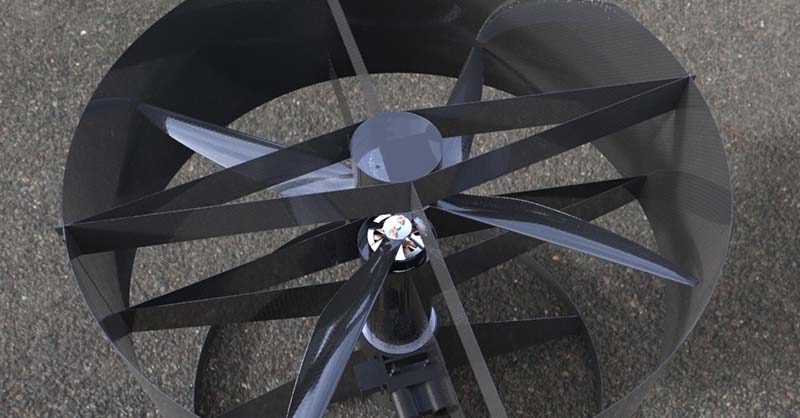[luca] has always wanted a flying robot, but despite the recent popularity of quadcopters and drones [luca] has never seen a drone that is truly autonomous. Although sometimes billed as autonomous, quadcopters and fixed wing aircraft have always had someone holding a remote, had to stay in a controlled environment, or had some off-board vision system.
Computers are always getting smaller and faster, battery and motor technology is always getting better. That’s why [luca] is building a truly autonomous flying robot for the 2016 Hackaday Prize.
Since [luca] is building a coaxial copter – something that looks like a ducted fan with a few vanes at the bottom – there will be control issues. Normal helicopters use the pitch of the blades and the torque produced by the tail rotor to keep flying straight. A quadcopter uses two pairs of motors spinning in opposite directions to stay level. With just two rotors mounted on top of each other, you would think [luca]’s coaxial copter is an intractable problem. Not so; there are bizarre control systems for this type of flying machine that make it as nimble in the sky as any other helicopter.
The design of this flying robot is a bit unlike anything on the market. It looks like a flying ducted fan, with a few electronics strapped to the bottom. It’s big, but also has the minimum number of rotors, to have the highest power density possible with current technology. With a few calculations, [luca] predicted this robot will be able to hoist an IMU, GPS, ultrasonic range finder, optical flow camera, and a LIDAR module in the air for about fifty minutes. That’s a remarkably long flight time for something that hovers, and we can’t wait to see how [luca]’s build turns out.




















Co-axial helicopters are normal helicopters too; they’ve been arround for ages.
https://en.m.wikipedia.org/wiki/Coaxial_rotors
Just it seems like the american constructors are not really good designing them :-)
I have coaxial Rc chopper sitting on my bench at the moment ( waiting for parts)
I’m curious how the control for this project works. The coaxial blades will enable the robot to go up, down and rotate left and right but doesn’t provide horizontal movement. The helicopter I have used a 3rdmotoronthe tail to raise and lower the tail which changes the attitude of the copter to allow it to move forwards and back wards.
Perhaps a weight (or even the payload) could be shifted fore and aft to achieve the same effect.
Take a look on MAV technology from Modlab (http://modlabupenn.org/)
https://www.youtube.com/watch?v=aEPf0QHVuMM
That’s crazy cool. I don’t quite get how it works, but that’s almost magical looking.
Nice! Now that could be used to make a real flying version of the camera drone prop used in the Tom Selleck movie “Runaway”.
Then you might get Gene Simmons running after you firing homing bullets and trying to attack you with acid injecting hexapod robots! I think we are closer to the technology in that movie than Back to the Future for sure.
Couldn’t you (partly) deflect the downward thrust with steerable vanes to get some sort of control?
That’s what I plan to do. I still need to figure out how big those steerable vanes need to be.
Cool cool cool cool cool want want want…
I want one with a bright LED illuminating me in the night. Because wearing a headlamp looks ridiculous.
Two isn’t the minimum number of rotors, a Coanda effect craft needs only one. Though I have no idea whether it would provide similar efficiency or flight time.
In theory you can build a normal helicopter without the tail motor. It will spin unless you provide some vanes to counteract the torque from the motor.
Coanda effect only redirects airflow over a surface, and doesn’t cancel the spinning torque, so it includes those vanes. I don’t think I’ve seen vanes used separately from a Coanda craft, but I have no doubt it could be done.
There’s so many ways to make something fly these days. It’s awesome.
I was looking at craft using the Magnus effect for wings last night. From watching them (not a scientific analysis), they seem to provide a lot of lift, for very little forward airspeed. Which makes me wonder, can you put two on a heli-style rotor? Would this allow driving the rotor more slowly, while still obtaining sufficient lift? Slow rotors generally means less noise and higher efficiency. (Although this config might produce some unusual gyroscopic effects).
There’s also fanwings, cyclogyros, and so on…
Hey,
Thanks for featuring my project, that was unexpected.
It is true that I’m not going for the most common propulsion/control method, we’ll see how that pans out, but I’ve got a good feeling. Regarding flight time, my calculations are only worth so much, but I’m confident it will exceed what is achievable in a quadcopter configuration.
Chris: you’re right, there the even more unusual Coanda effect craft. I’ve never seen one in real life and doubt it is very efficient, but I haven’t done any simulations. My project is already risky enough as it is :)
This reminds me of this from 2011.
http://www.popsci.com/technology/article/2011-10/video-japans-new-ball-shaped-drone-wows-crowds-tokyo